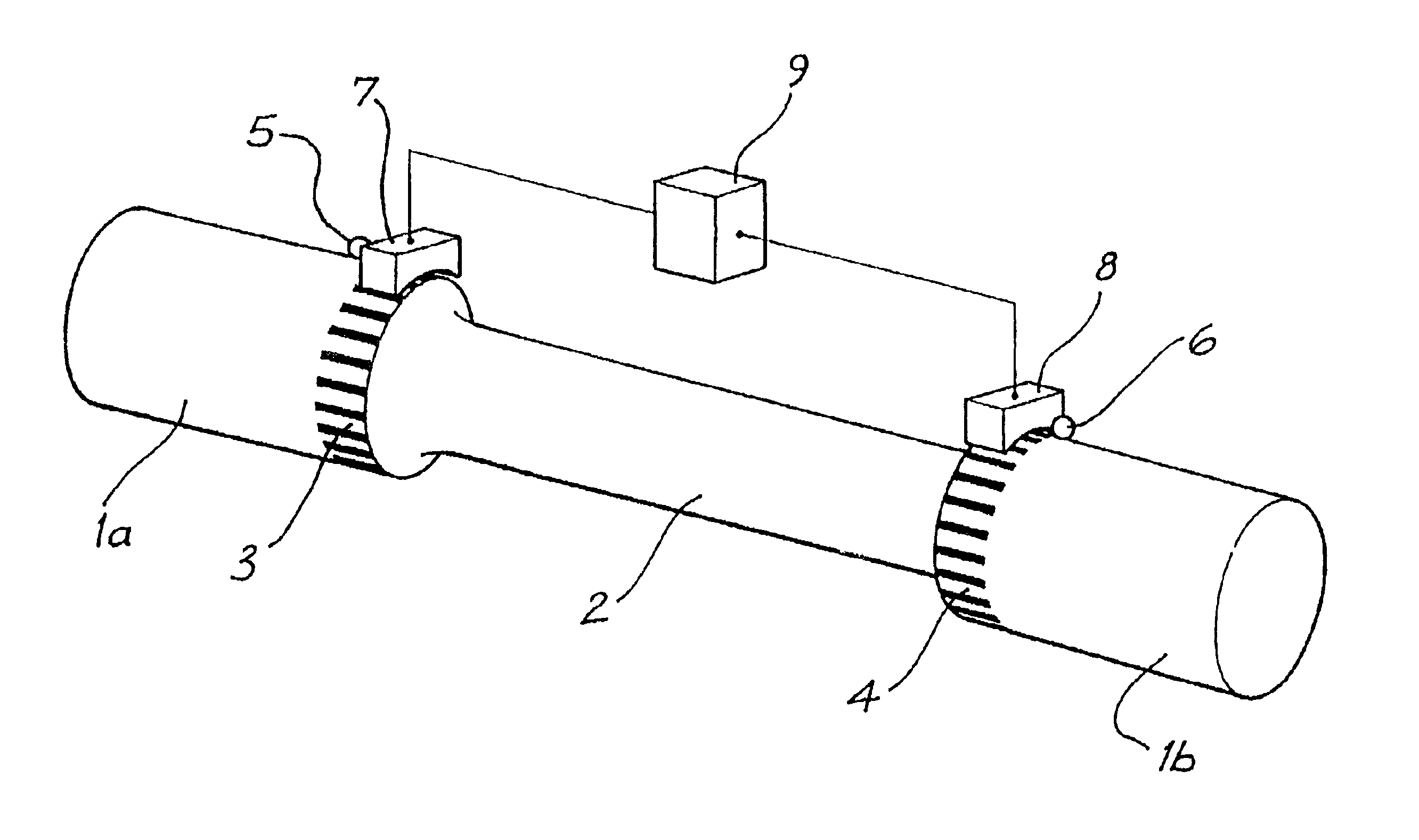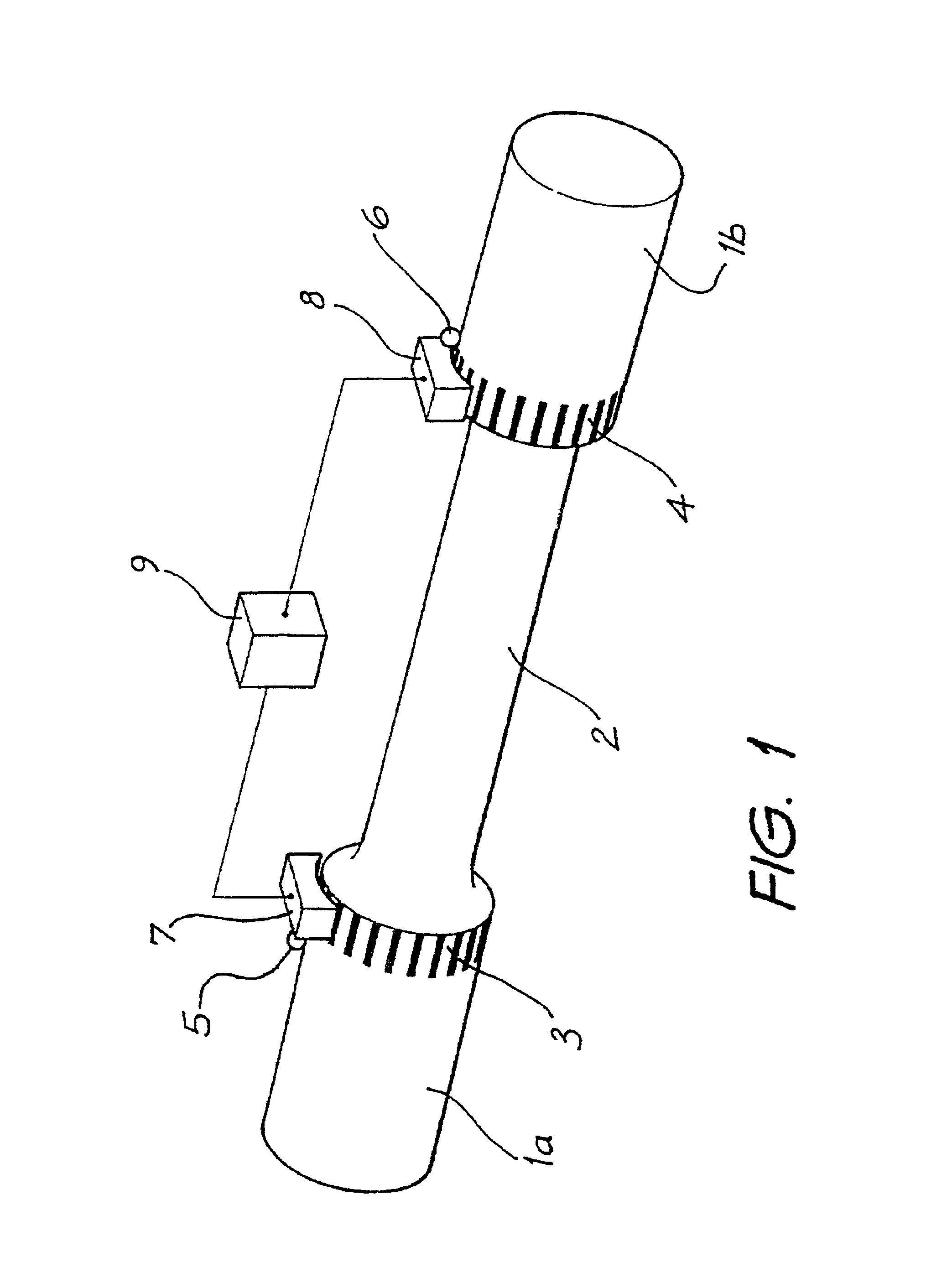Sensor for sensing absolute angular position of a rotatable body
a technology of angular position and sensor, which is applied in the direction of instruments, force/torque/work measurement apparatus, material analysis, etc., can solve the problems of space and cost, slowness and more prone to error, and device is prone to error
- Summary
- Abstract
- Description
- Claims
- Application Information
AI Technical Summary
Benefits of technology
Problems solved by technology
Method used
Image
Examples
first embodiment
FIG. 2 shows a cross section of a torque transducer according to the present invention, using the principles shown in FIG. 1. Cylindrical grating elements 3 and 4, comprising surfaces composed of alternating high and low reflectivity, are attached to torque input members 1a and 1b which are connected to either end of the torsion bar 2. In other (not shown) embodiments either (or both) grating elements may be integral with their respective torque input members. The assembly is enclosed in housing 10 and supported by bearings 11 and 12. EMR sources 5 and 6 are disposed to illuminate the surfaces. Arrays 7 and 8 of detectors receive incident EMR from the surfaces and the patterns thus generated on the arrays are processed by a processor 9 to provide a measurement of torque. When torque is applied between torque input members 1a and 1b torsion bar 2 angularly deflects, resulting in a displacement of one pattern with respect to the other. Failsafe mechanism 15 limits the maximum torque c...
second embodiment
FIGS. 4, 5 and 6 shows the present invention. Cylindrical grating elements 21 and 22 are attached to torque input members 1a and 1b, connected to either end of the torsion bar 2. The outer cylindrical surfaces of grating elements 21 and 22 are discontinuous and are formed in part by substantially axially aligned, radially protruding castellations 13 and 14 respectively. The regions of high reflectivity correspond to the areas of maximum radius of the castellations with respect to their mutual central axis 16, that is outer peripheral areas 13a and 14a respectively, and may be smoothly machined, moulded or sintered, or surface treated with paint or material deposition to impart the required high reflectivity. The regions of low reflectivity are angularly aligned with the discontinuous gap areas of the outer cylindrical surfaces of grating elements 21 and 22, namely areas 13b and 14b respectively and, in the embodiment shown here, are substantially non-reflective due to the presence o...
fourth embodiment
FIGS. 10 and 11 show the present invention. Grating elements 29 and 30, again respectively attached to torque input members 1b and 1a, incorporate continuous, radially disposed surfaces 23 and 24. These radially disposed surfaces are arranged perpendicular to, and have a mutual central axis collinear with, axis of rotation 16. Each surface comprises substantially radially disposed alternating regions of high and low reflectivity 27 and 28 respectively. Grating elements 29 and 30 are surrounded by housing 10 and the assembly carried in bearings 11 and 12. EMR sources 31 and 32 are disposed to illuminate the surfaces. Arrays 33 and 34 of detectors receive incident EMR from the surfaces and the patterns thus generated on the arrays are processed by processor 9. When torque is applied between torque input members 1a and 1b, torsion bar 2 angularly deflects, resulting in a displacement of one pattern with respect to the other. Failsafe mechanism 15, shown in cross section in FIG. 7, limi...
PUM
| Property | Measurement | Unit |
|---|---|---|
| angle | aaaaa | aaaaa |
| angle | aaaaa | aaaaa |
| length | aaaaa | aaaaa |
Abstract
Description
Claims
Application Information
 Login to View More
Login to View More - R&D
- Intellectual Property
- Life Sciences
- Materials
- Tech Scout
- Unparalleled Data Quality
- Higher Quality Content
- 60% Fewer Hallucinations
Browse by: Latest US Patents, China's latest patents, Technical Efficacy Thesaurus, Application Domain, Technology Topic, Popular Technical Reports.
© 2025 PatSnap. All rights reserved.Legal|Privacy policy|Modern Slavery Act Transparency Statement|Sitemap|About US| Contact US: help@patsnap.com



